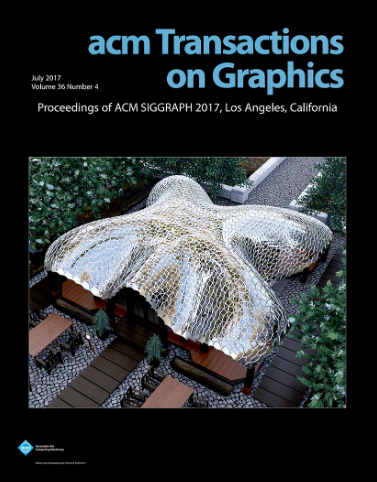即时自交叉修复3D网格
IF 9.5
1区 计算机科学
Q1 COMPUTER SCIENCE, SOFTWARE ENGINEERING
引用次数: 0
摘要
由于缺乏时间运动和穿透深度信息,静态3D表面网格中的自相交修复提出了独特的挑战,这两个关键元素通常在基于物理的方法中使用。我们引入了一个新的框架,通过结合局部符号切点能量及其梯度扩散,将局部接触处理转化为全局修复策略。我们的方法的核心是一个关键的见解:而不是计算昂贵的全局排斥势,我们可以有效地近似远程相互作用,通过扩散能量梯度从局部接触到整个网格表面。反过来,解决复杂的自交减少到简单地传播局部排斥能通过标准扩散力学和迭代求解可处理的局部优化。我们通过基于动量的优化器进一步加速收敛,该优化器基于梯度统计自适应调节动量,以防止超调,同时保持快速的交叉修复。由此产生的算法可以处理各种具有挑战性的场景,从浅接触到深穿透,同时提供适合交互式应用的计算效率。本文章由计算机程序翻译,如有差异,请以英文原文为准。
Instant Self-Intersection Repair for 3D Meshes
Self-intersection repair in static 3D surface meshes presents unique challenges due to the absence of temporal motion and penetration depth information—two critical elements typically leveraged in physics-based approaches. We introduce a novel framework that transforms local contact handling into a global repair strategy through a combination of local signed tangent-point energies and their gradient diffusion. At the heart of our method is a key insight: rather than computing expensive global repulsive potentials, we can effectively approximate long-range interactions by diffusing energy gradients from local contacts throughout the mesh surface. In turn, resolving complex self-intersections reduces to simply propagating local repulsive energies through standard diffusion mechanics and iteratively solving tractable local optimizations. We further accelerate convergence through our momentum-based optimizer, which adaptively regulates momentum based on gradient statistics to prevent overshooting while maintaining rapid intersection repair. The resulting algorithm handles a variety of challenging scenarios, from shallow contacts to deep penetrations, while providing computational efficiency suitable for interactive applications.
求助全文
通过发布文献求助,成功后即可免费获取论文全文。
去求助
来源期刊

ACM Transactions on Graphics
工程技术-计算机:软件工程
CiteScore
14.30
自引率
25.80%
发文量
193
审稿时长
12 months
期刊介绍:
ACM Transactions on Graphics (TOG) is a peer-reviewed scientific journal that aims to disseminate the latest findings of note in the field of computer graphics. It has been published since 1982 by the Association for Computing Machinery. Starting in 2003, all papers accepted for presentation at the annual SIGGRAPH conference are printed in a special summer issue of the journal.
 求助内容:
求助内容: 应助结果提醒方式:
应助结果提醒方式:


